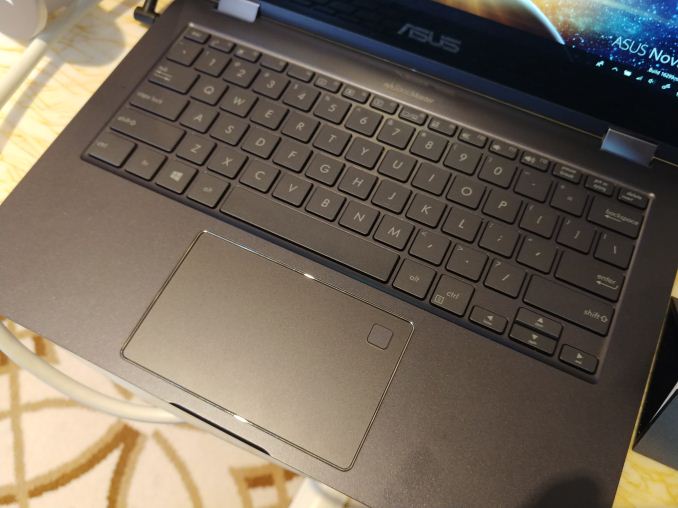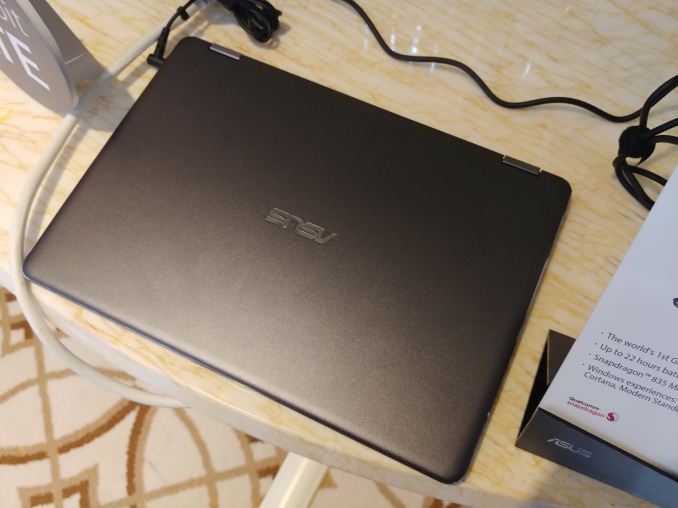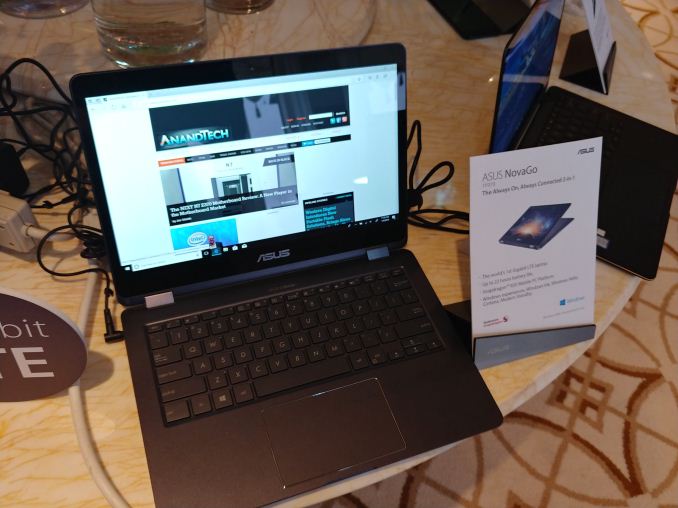The ASUS NovaGo: Two Minutes with Snapdragon 835 and Windows
by Ian Cutress on January 17, 2018 8:00 AM EST
LAS VEGAS, NV – Late last year, at Qualcomm’s Snapdragon Tech Event in Hawaii, we had the formal introduction of the first devices that were using the new Windows on Snapdragon platform and Qualcomm’s dream of bringing mobile technology to laptops to provide ‘Always Connected PCs’, connected through an LTE data connection. Qualcomm sells the upsides of this technology of providing laptops with 20hrs+ of battery life through using a smartphone processor, and through working with Microsoft, have a full version of proper Windows based on the system. The devices use native apps for best performance through the Windows Store, however 32-bit apps are machine translated into instructions that the Snapdragon SoC can process. It’s a lot of technology in a tiny device, and Qualcomm would seem to be the first CPU manufacturer to actually pull off x86 translation for the consumer market.
All of that aside, one of the first devices that should enter the market is the ASUS NovaGo. This is a 13-inch premium laptop/360-degree 2-in-1 design that has features such as Windows Hello and a fingerprint sensor built in while maintaining ASUS’ laptop quality and claiming up to 22 hours of battery life. We have wanted to get our hands on one for a while, and I managed to get a couple of minutes at the show with one at the ASUS suite.
Truth be told, the main fear that we have had with these devices is responsiveness. Smartphones on Android can be fast, with but something much bigger like Windows, it was not always on the cards that we would get the same level of responsiveness as, say, a Y-series Intel design. Back when we saw a super-early demo behind closed doors at IFA, it wasn’t the fastest, but on the NovaGo at least, everything seemed in order. Basic applications were quick and easy to open, and no visible lag from my untrained eye. Using the native compiled version of Edge, the best website in the world loaded as it normally does, and I was able to navigate the device as I would do normally with an Intel based laptop. Being familiar with ASUS’ device design, there were no surprises in the feel of the keyboard and touchpad either. Port support extends to a 3.5mm jack, a HDMI port, and two USB 3.0 ports.
A quick look through the system settings showed eight Snapdragon 835 cores, the Adreno graphics, and a PCIe based SSD for storage if I remember correctly. With it being connected to the internet, I tried downloading CPU-Z, even in 32-bit, but it required me adding it through the Store page to get it to work. Alas, the Wi-Fi at the Las Vegas Encore was not giving me any favors with the Windows Store so I was unable to go down that route, so at some point I obviously want to see the effects of x86 translation.
We were told by Qualcomm at the event a number of interesting things about the design of the platform, and how it has changed since we last met with them. Windows scheduler is configured to deal with cores of different level of performance, and it knows what programs are where and how to deal with them for performance and power, much like a good Android based scheduler. This was one of our worries, but we were categorically told that any internal worries they ever had are now fixed and it should run like a well-oiled machine.
In gaming, Qualcomm stated that with the modern APIs, the Adreno GPU is natively compiled and doesn’t need translation. As a result, due to the way that Adreno works, for some titles it ends up being more computationally efficient over other solutions and causes less work on the CPU, allowing for more of the power budget on the GPU and an overall better frame rate. Obviously we want to get a hold of the device and test the claim, but if offers an interesting prospect.
As for the NovaGo, with the addition of LTE and if it stands up to the battery life claims, it could be a neat little device depending on the price. ASUS said they expect it to launch sometime during Q2.















76 Comments
View All Comments
DanNeely - Wednesday, January 17, 2018 - link
I'm concerned about long term driver support. We recently had one of the generations of atom CPUs that used a non-Intel GPU fall out of new major Win10 updates (and onto a long term bug-fix only branch originally intended just for enterprise use) because it needed a new driver that was never made. We all know a major part of the Android update farce is that SoC makers only provide a year or two of driver updates before abandoning them for newer models. With the 5+ year lifespan of typical Windows laptops that's a disaster waiting to happen even assuming it doesn't end up abandoned by MS like Win8RT was.ikjadoon - Wednesday, January 17, 2018 - link
This is key. Nobody is craving for Qualcomm’s abandonment routine that they run around with impunity on Android “because they can”.lmcd - Wednesday, January 17, 2018 - link
Qualcomm's "abandonment" routine on Android has no comparisons to the ImgTech disaster referred to in Dan's comment.Also, Windows 10's driver model is likely to stay stable for most, if not all, of the lifespan of the laptop anyway. Android by comparison is a far more varying target.
ikjadoon - Wednesday, January 17, 2018 - link
>Qualcomm's "abandonment" routine on Android has no comparisons to the ImgTech disaster referred to in Dan's comment.Is it not the same issue? Cheap hardware losing software support after a few months?
>Also, Windows 10's driver model is likely to stay stable for most, if not all, of the lifespan of the laptop anyway. Android by comparison is a far more varying target.
I don't see Android's driver model changing so significantly to deny updates. I think you're ignoring the business side of this: cost/benefit analysis. Qualcomm made the cheaper choice.
serendip - Wednesday, January 17, 2018 - link
On Android, Qualcomm only writes drivers for board support packages. Manufacturers then take those drivers, integrate them with their own software and Android base to create an Android release. Most of the time, manufacturers don't bother with updating drivers for older phones and tablets.For Windows, Qualcomm will have to write drivers for every one of their chips on these upcoming ARM machines and support them for much longer than on Android. That's a good thing and hopefully it transfers over to Android as well.
ZolaIII - Thursday, January 18, 2018 - link
Well honey CAF suport is open, OEM's are the usual shits, there are QC SoC's with lasting support for longer than 5 years & rare examples for cheap smartphones with also such long suport as Xiaomi Redmi S1 with S400.euskalzabe - Wednesday, January 17, 2018 - link
Interesting. I'm still rocking my 3 year old UX305, the Novago could be an interesting laptop update. If the performance is similar and I gain 20h of battery life... might be worth considering.HardwareDufus - Wednesday, January 17, 2018 - link
Be interesting to see some of these devices with the upcoming SD845 in the not too distant future.ikjadoon - Wednesday, January 17, 2018 - link
Qualcomm confirmed they are. “Wave 2” devices.serendip - Wednesday, January 17, 2018 - link
Which is why it's dumb for Qualcomm and OEMs to use the SD835 in machines that will debut in Q2-Q3, when SD845-based phones would have been out for a quarter or longer. If these ARM Windows machines are to last 5 years like typical laptops, they should have the latest chips on release, unless they're intended to be throwaway devices like cheap Atom junk.